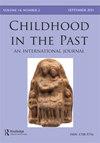首都的传染病:探索19世纪英国伦敦城市化和传染病风险对儿童健康的影响
IF 0.5
Q3 ANTHROPOLOGY
引用次数: 1
摘要
19世纪的伦敦因人口拥挤、住房条件差和严重的空气污染而臭名昭著。由于很大一部分人口生活在贫困中,人们越来越多地被吸引到英格兰的工业化中心寻找就业机会,疾病也随之泛滥。利用历史文献和骨骼证据,本文探讨了日益增长的城市化对非成人(0-17岁)健康的影响,特别是在这一时期接触多种传染病的影响。该报告以伦敦圣布莱德教堂社区为重点,强调婴儿和儿童更容易受到传染病严重发病率和死亡率的风险,特别是在下层阶级中。当考虑到19世纪伦敦的社会政治、文化和经济环境时,这揭示了城市化的多方面进程如何加剧了健康状况不佳,增加了对致命传染性病原体的易感性,并最终进一步边缘化了最贫穷的居民。本文章由计算机程序翻译,如有差异,请以英文原文为准。
Contagion in the Capital: Exploring the Impact of Urbanisation and Infectious Disease Risk on Child Health in Nineteenth-Century London, England
ABSTRACT
Nineteenth-century London was notorious for overcrowding, poor housing, and heavy air pollution. With a large proportion of its population living in conditions of poverty, diseases flourished as people were increasingly drawn to the industrialising centres of England in search of employment opportunities. Utilising historical documentary and skeletal evidence, this paper explores the impact of increasing urbanisation on non-adult (those aged 0–17 years) health, particularly in relation to exposure to a multitude of infectious diseases in circulation during this time. Focusing on the community of St Bride’s Church, London, it highlights the greater susceptibility of infants and children to risk of severe morbidity and mortality from infectious diseases, particularly amongst the lower classes. When considered against the socio-political, cultural and economic milieu of nineteenth-century London, this reveals how the multi-faceted process of urbanisation exacerbated ill-health, increased susceptibility to deadly infectious pathogens, and ultimately further marginalised its poorest inhabitants.
求助全文
通过发布文献求助,成功后即可免费获取论文全文。
去求助
来源期刊

Childhood in the Past
Social Sciences-Anthropology
CiteScore
0.90
自引率
0.00%
发文量
16
期刊介绍:
Childhood in the Past provides a peer-reviewed, interdisciplinary, international forum for the publication of research into all aspects of children and childhood in the past, which transcends conventional intellectual, disciplinary, geographical and chronological boundaries. The editor welcomes offers of papers from any field of study which can further knowledge and understanding of the nature and experience of childhood in the past.
 求助内容:
求助内容: 应助结果提醒方式:
应助结果提醒方式:


